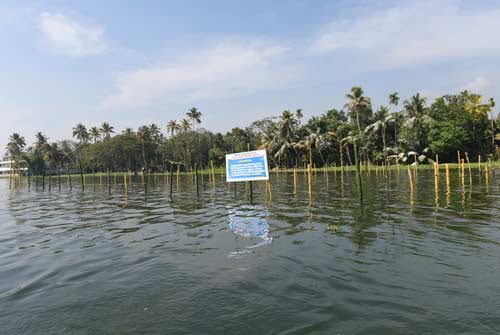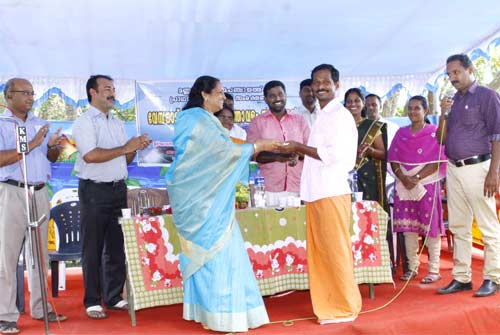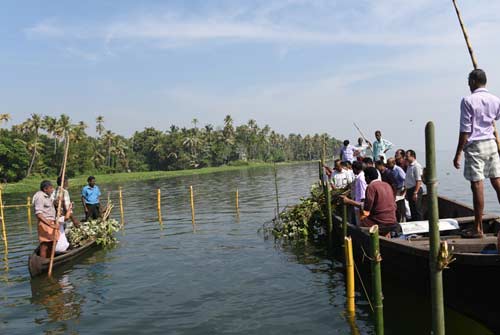Fish Sanctuaries for Sustainable Livelihoods: World Wetlands Day Celebration 2016 in Kerala, India - Feb. 2, 2016
World Wetlands Day (WWD) 2016 was celebrated in Kerala, India by dedicating five small fish sanctuaries in Vembanad Lake - a fitting manner to the theme of this year’s WWD ‘Wetlands for Our Future: Sustainable Livelihoods.’ It was a joint effort by Community Environment Resource Centre (CERC) of Ashoka trust for Research in Ecology and the Environment (ATREE, Bangalore), Mannanchery Grama Panchayat (local self-government) and Federation of Vembanad Lake Protection Forums. Vembanad Lake protection forums are grassroot democratic insititutions pledged to the cause of conservation and sustainablity of Vembanad Lake - the largest Ramsar Convention site on the West Coast of India. The fish sanctuaries are designed according to the traditional wisdom of the fisher folk. Department of Environment and Climate Change (Government of Kerala), has provided the necessary financial support for this under its Primary Environment Care scheme.
|
It is an informal rule among the local fishing communities to avoid fishing around the sanctuaries. Photo credit: Ashish George. |
Fisher folks in Vembanad (Kerala, India) have several nostalgic stories on the abundance and diversity of fish available here once. The traditional fisher folks were always following environmentally sustainable fishing practices by forging and maintaining frontiers and enforcing behavioral norms within the community. They refrained from fishing the brooders and avoided catching the juveniles. Still they were getting a decent income from the fishery and an additional income from black clam (Villorita cyprinoides) meat and shells, which were plentiful there.
|
Small grants are distributed to Lake Protection Forum members for constructing the fish sanctuary. Photo credit: Ashish George. |
The more recent anthropogenic interventions on Vembanad Lake, such as increased land reclamation and building of a salt-water barrier to intensify rice cultivation and sudden growth of backwater tourism, have reduced the lake and polluted the water, dwindling the fishery resources. The intensive agriculture and tourism have reduced the operational space for fishers and changed the social and ecological dynamics in Vembanad. The increased demands and reduced resources compelled the fishers to adopt unconventional fishing methods resulting in further scarcity. At the same time, conservation endeavors in this landscape have not been successful owing to the existence of multiple agencies having control over various activities, with minimal coordination or cooperation. ATREE is attempting to address some of these issues through the Community Environmental Resource Centre established at Alappuzha (Kerala, India). CERC brings together local communities and institutions to strengthen wetland management in Vembanad.
|
Mr. Venugopal (President, District Panchayat Alappuzha, India) formally dedicating fish sanctuary in a public meeting at Mannanchery Panchayat. Photo credit: Ashish George. |
During a dialogue, the fisher folk pointed to the diminution of mangroves around the lake as an important reason for the dwindling fishery. The mangroves were a breeding ground and nursery for the native fish. As an alternative to the lost mangroves - which are not possible to restore as the coastlines are alienated by developmental activities - they suggested the use of padals to create artificial sanctuaries for the fish. Padal fishing was a traditional method of fishing in Vembanad Lake, which has been discontinued as it kills brooders. The bundles of foliage are submerged into the lake, provide an ideal place for the fish to hide and breed and the fishers encircle the padals and catch fish in the area.
|
Padal provides ideal habitat for fish to breed and hide from predators. As seen in the photo, everyone together - officials of Mannanchery Panchayat, CERC-ATREE and members of Lake Protection Forums with the District Panchayat President Mr. Venugopal, are formally inaugurating the fish sanctuary by submerging padals into the sanctuary. Photo credit: Ashish George. |
A modification of this padal system was adopted for constructing fish sanctuaries – Matsyathavalams in local language - where the padals are fixed to the lake bed and bamboo fencing was provided to prevent other fishers from entering into it. The community, with the support of local government institutions, declared the area around it as ‘non- fishing zones.’ The fisher folk avoid fishing in these areas, spread the message among others and Lake Protection Forum members keep a vigil eye to prevent fishing within the non-fishing zones. An independent evaluation of the efficiency of the sanctuary conducted by a group of fishery experts found healthy reproductive populations and large shoals of fish larvae in the sanctuaries compared to other similar locations in the lake. The larger presence of top predators like otters and cormorants in the sanctuary zones obviously indicate the richness of fish.
World Fish Migration Day 2016: Panel Discussion and seminar on ‘Linking Rivers, Barrages and Fish Migration,' on May 21, 2016
CERC has decided to celebrate the World Fish Migration Day 2016 with a panel discussion and seminar on ‘Linking Rivers, Barrages and Fish Migration’ on May 21, 2016.
In India, interlinking of rivers – linking all major rivers in the Himalayas and Peninsula through an extensive barrier and canal system - is projected as the only solution to all water problems. The proposal received the unstinted support from all developmental aspirants. India’s Supreme Court has provided necessary legal clearance to the project and overruled all ecological and socio-economic concerns raised against the project. In the meantime, all major fluvial systems are interrupted by series of barriers. This includes small weirs to large dams and salt water barriers preventing saline incursion to the estuarine lakes. All these obstacles to the natural flow impede the movement of fish impacting their population and the livelihood of the fishers.
Community Environment Resource Centre (CERC) of Ashoka trust for Research in Ecology and the Environment (ATREE, Bangalore) has planned to celebrate World Fish Migration Day 2016 with a panel discussion on ‘River Linking, Barrages and Fish migration’ to bring these issues to attention of the policy makers. The Kerala State Fisheries Department and Kerala University for Fisheries and Ocean Sciences (KUFOS) will be partnering with this event.
The panel discussion will be followed by the two-day Vembanad Fish Count 2016, the 9th episode of annual participatory fishery assessment.
Prepared by: Priyadarsanan Dharma Rajan & Ashish Mathew George
Ashoka Trust for Research in Ecology and the Environment (ATREE)
Royal Enclave, Srirampura, Jakkur Post, Bangalore - 560 064, India.
Email: priyan@atree.org



